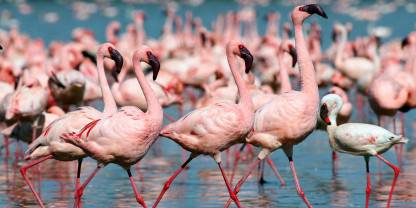Average Expert Rating
Rating Breakdown
Write a User ReviewRewarding Game-Viewing, Even on a Short Visit, Combined With Great Lake Views
Read more
and are easily seen. It certainly won’t be wild enough for some, but is easy to navigate and a game-viewing circuit only takes about three hours – even by taxi or on a game drive booked at the gate. My top tip is to take a picnic and admire the new shapes and colours of the lake from the lookout at Baboon Cliffs.Flamingos, Rhinos and Big Cats
Flamingos aside, the wildlife viewing tends to be very good. On our last visit, we had seen four of the Big Five within 24 hours (there are no elephants) and much more. We saw the same beautiful male leopard on every drive (trying to catch rats on the road), an exciting but heartbreaking scene of lions hunting a new-born buffalo calf, and a three-way standoff between black rhinos, a white rhino and a few buffalo bulls all fancying the same shady spot under an acacia tree. Last but not least we can confirm that lions still love climbing trees here. We stayed in the Kenya Wildlife Service (KWS) Naishi self-catering
Read more
guesthouse and saw a huge buffalo herd coming to drink at our private water hole while barbecuing. It really felt like we were the only people in one of Kenya’s most popular parks. What a privilege!Lake of Birds and Land of Rhinos
Fortunately, Nakuru still supports exceptionally high densities of both species of rhino, which have been introduced here because it is relatively easy to monitor for poachers. The larger and more peaceable white rhino is probably seen here more easily than it is in any other East African national park; good places to look for it include the southeastern lake floodplain
Read more
around Rhino Point and areas of open savannah in the park’s far south. The smaller, crankier and more secretive black rhino tends to stick to thick acacia woodland, where it is quite common, but often challenging to locate.Other wildlife likely to be seen in Lake Nakuru National Park includes the localised Rothschild’s giraffe, and plentiful buffalo, zebra and waterbuck. On our most recent visit, in 2024, we had several excellent sightings of leopards and tree-climbing lions around Rhino Point. And even without flamingos, this small national park – listed as a Ramsar wetland and Important Bird Area – supports a remarkably diverse and exciting avifauna, with impressive flocks of great white pelican the stars of a bird checklist that includes more than 450 species.
Lake Nakuru: Flamingos and the Big Four
Read more
of people chopping wood can often be heard here and it always takes the edge off what is otherwise a wonderful park experience.Kenya’s Flamingo and Rhino Capital
It’s less than an hour’s drive from Nakuru city centre to Lake Nakuru National Park and less than three hours from Nairobi.
The park’s main attraction used to be the thousands and sometimes millions of lesser flamingos that foraged along its shores, but these birds are no longer a reliable presence due to changes in the water level. Nakuru also has strong populations of both white and black rhino, which have both been introduced. This has necessitated constructing a fence around the entire park to help prevent poaching, and this undoubtedly takes something away from the natural feel of the place.
Rothschild’s giraffes were also relocated here from the west of the country back in the late 1970s and lion and leopard are here too, though my experience tells me that sightings are infrequent.
As with all of the Rift Valley’s soda lakes, though the flamingos tend to steal the show, there are myriad other interesting bird species to be found.
One of Kenya’s Flagship Parks, Famous for Its Flamingos
It’s now many years since the gigantic flocks of flamingos that used to grace Lake Nakuru began to diminish in number, thanks to a change in the chemical makeup of the water. Even so, the image of that shimmering vision in pink remains a Kenyan icon, and it’s rare for the flocks to be absent altogether. In fact, some flamingos have returned. When I visited, there was a healthy number of lesser flamingos gracing the water, along with crowds of pelicans.
There’s more to the park than the lake – acacia woodland surrounds the water, and it’s easy to drive around looking for rhinos, giraffes and baboons. I saw a good number of waterbuck at unusually close range – the park is an excellent place to watch them as vehicles don’t seem to disturb them unduly. Just as well, as there are always plenty of vehicles here – the park is right next to the busy town of Nakuru, and very accessible.
A Feel-Good Park With Spectacular Scenery
I was lucky enough to see the famed tree-climbing lions though, one with its head poking out the top of a squat acacia and the other crouched on a lower branch. Who says lions don’t climb trees? Here they do!
The flamingos used to be a big drawcard of this park. Most departed for richer feeding grounds a few years ago due to rising water levels, but small
Read more
flocks are still quite often seen here. Apart from flamingos, the lakeshore is a rich repository of other birdlife, and birders have hundreds of different species to discover.This is a park I would definitely spend more time in and I recommend a couple of days here at least.

